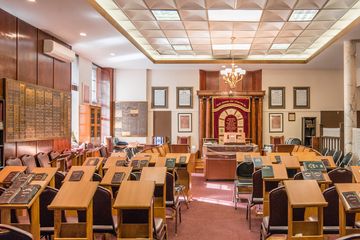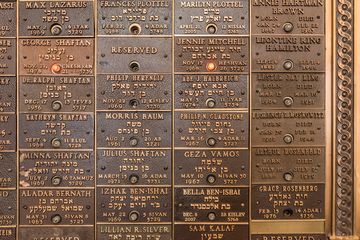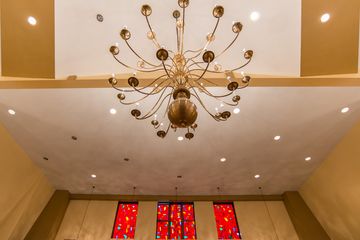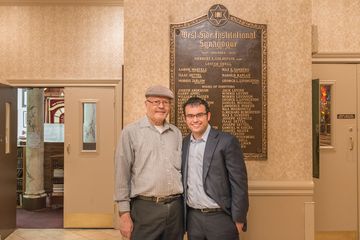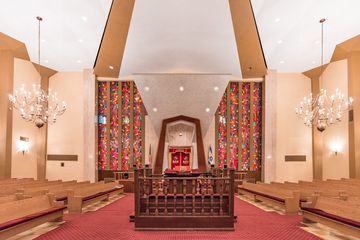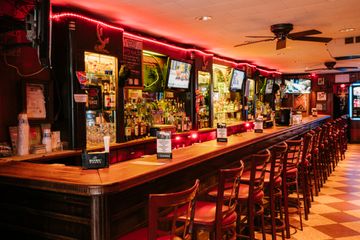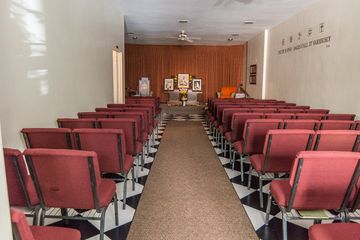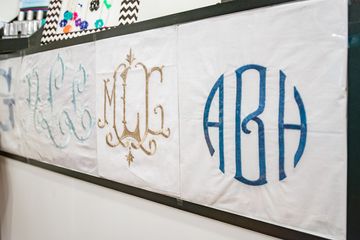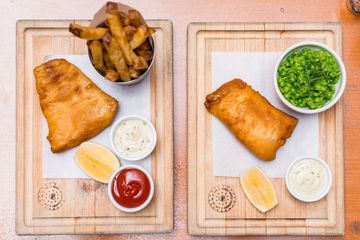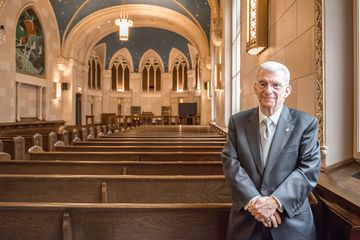
The West Side Institutional Synagogue, with its towering stone walls and ornamental turrets, is a building of religious importance, though the worshiping that takes place inside may not be clear from the outside. This is because the building was originally erected as a Methodist church in 1889, but then became the home to the synagogue in 1937. Chet Lipson, a member of the congregation, and the temple’s Rabbi, Daniel Sherman, offered to give us a tour of the magnificent structure.
The annex, which was added to the main synagogue in 1958, as the stone plaque outside indicates, houses both a preschool and a senior center. Our two guides led us past small children and strollers into the room where the morning services take place. The space is primarily used by Tifereth Yisrael, the Yemenite group that rents the room from West Side Institutional. We then entered the main sanctuary, which, given that WSIS is orthodox, is split up into a men’s and a women’s section. Rabbi Sherman elaborated, however, that the gender separation is only enforced during prayer and that co-ed seating is allowed during lectures and speeches. I was amazed at the size of the room, which the men boasted seats some 600 people and is considered to be the second largest sanctuary on the West Side.
On a separate occasion, I had the pleasure of speaking with Rabbi Aaron Reichel, a practicing attorney, whom the other two men referred to as the synagogue’s historian. He explained that the congregation was formed in 1917 and began holding events in theaters in Harlem. In the early twentieth century, Harlem had the third largest concentration of Jews in the world, after Warsaw, Poland and the Lower East Side. During its heyday, the Institutional Synagogue’s Hebrew School contained a thousand students and over three thousand people passed through the doors of the synagogue each day. When the Jewish population started shifting away from Harlem, the synagogue ultimately moved downtown, landing in its current location. The congregation changed the stained glass windows of the old church, covered the murals, and removed the organ, turning the structure into a new kind of religious home. In the 1960s, however, there was a fire that destroyed the interior. They managed to save the torahs, but the sanctuary had to be rebuilt.
While sharing photos of the reconstruction with me, Aaron spoke of the highly regarded Rabbi Herbert S. Goldstein, who founded the synagogue and was an incredibly influential figure in Jewish-American history. Aaron's passion for this great man, which inspired him to write The Maverick Rabbi, is especially understandable, considering Rabbi Goldstein was Aaron’s grandfather. Aaron gave me the shortlist of the Rabbi’s accomplishments, including making kosher food available on a national scale, becoming president of the Union of Orthodox Jewish Congregations of America, and being one of the first American-born orthodox rabbis. Rabbi Goldstein’s goal for the synagogue was to make it both 100% orthodox and 100% American, with an equal emphasis on Judaism and patriotism. I was particularly touched when Aaron mentioned that the synagogue hosted monumental Thanksgiving parties and that many of its congregants joined the army to fight in both World Wars, with Rabbi Goldstein sending them rousing letters throughout their time in service.
Aaron’s interest in the synagogue is both personal and academic. He has done an extraordinary amount of research on the building and its influential members, but he also has been an active member of the synagogue for a large portion of his life...it was his father who married Rabbi Goldstein’s daughter and took over in 1960. Aaron would sometimes unofficially fill in for his father when he was away, as he was the one who had his finger on the pulse of the temple. He noticed that after the fire, the synagogue took a while to return to its former glory. He thanks Rabbi Shlomo Einhorn, however, for reinvigorating WSIS in the 2000s. He credits the rabbi with “building up the synagogue again.” He also believes the synagogue is fortunate to have the dynamic Rabbi Sherman as its spiritual leader today, "to lead it into a future that will hopefully not just match but exceed the synagogue’s glorious past."

